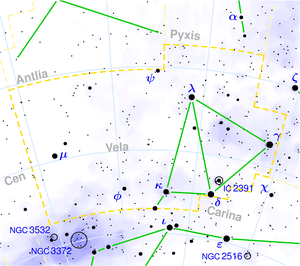|
|
Vela ( Latin: sails) is a southern constellation, one of the four parts into which Argo Navis was split (the others being Carina, Puppis and Pyxis). Notable features The brightest star in the constellation, γ Velorum, is a bright 1.75m supergiant star. The star is actually quintuple, the primary component is famous for being the brightest Wolf-Rayet star in the sky. This star is also sometimes called Regor, of an onknown origin. κ Velorum is also called Markeb. λ Velorum is also called Suhail, Arabic for lucky. The constellation Vela is in the west sky. Notable deep sky objects Of the deep sky objects of interest in Vela is a planetary nebula known as the NGC 3132 (nicknamed Eight-burst nebula). Also of interest within the constellation is the Vela Supernova Remnant. This is the nebula of a supernova explosion which is believed to have been visible from the Earth around 10,000 years ago. The remnant contains a pulsar which was the first pulsar to be identified optically. The Gum Nebula is a faint emission nebula, believed to be the remains of a million year old supernova. History Vela is one of the four constellations that made up the old constellation of Argo Navis, the ship of the Argonauts: Vela is the sail. False Cross The False Cross is an asterism formed of the stars δ Velorum and κ Velorum and ι Carinae and ε Carinae. It is sometimes mistaken for the Southern Cross, causing errors in astronavigation. References * Ian Ridpath and Wil Tirion (2007). Stars and Planets Guide * Richard Hinckley Allen, Star Names, Their Lore and Legend, New York, Dover, various dates.
Retrieved from "http://en.wikipedia.org/"
|
|
|||||||||||||||||||||||||||||||||||||||||||

